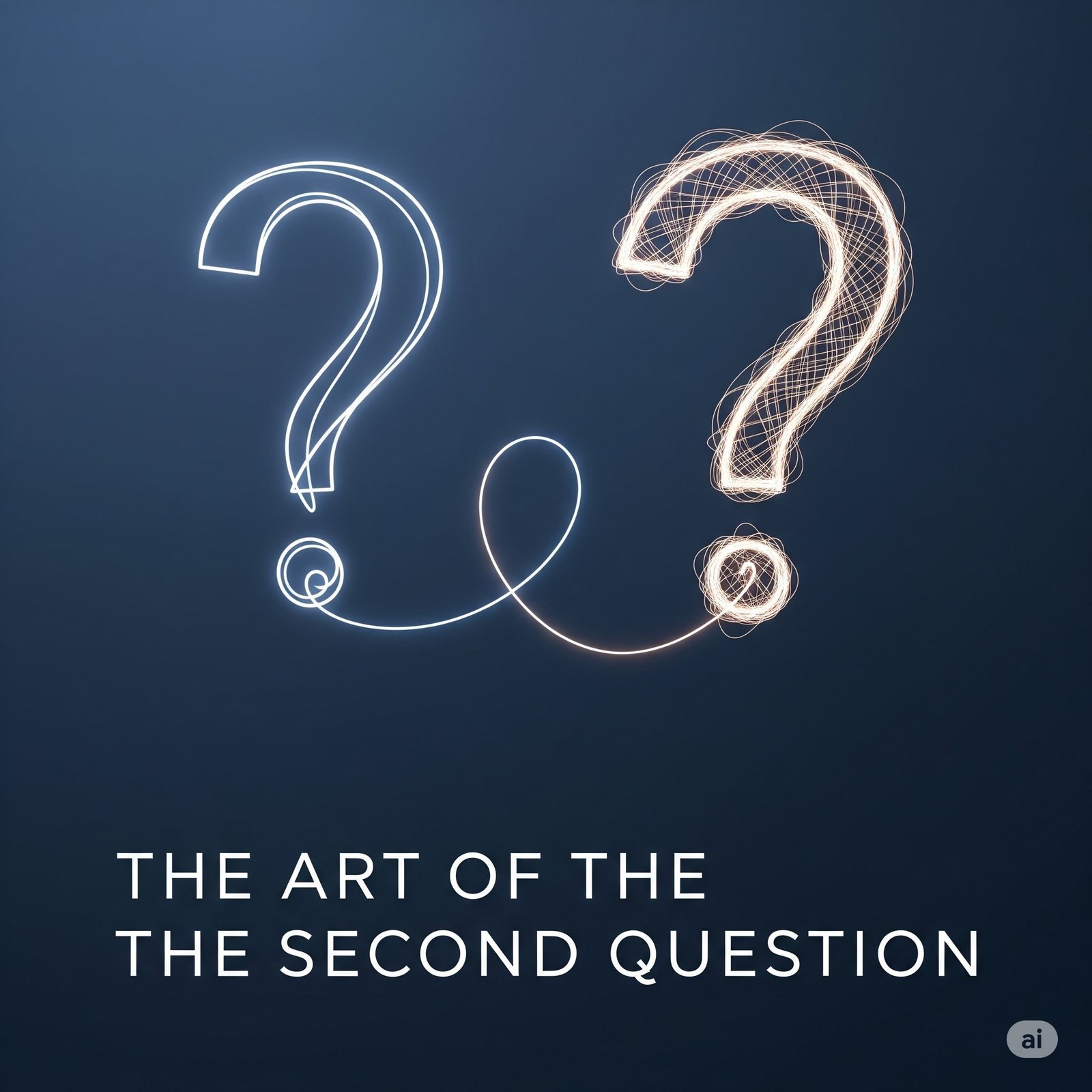We’ve all been there.
You ask the AI a question—a sincere, hopeful query—and you get an answer that is technically correct but emotionally, strategically, and practically useless. It’s a perfectly formed paragraph of nothing. A beautifully structured void.
You close the tab with a familiar sense of disappointment. “It’s just not there yet,” you think.
But what if the failure wasn’t in the AI’s answer, but in our question? What if the problem isn’t the technology, but our interaction with it?
Change rarely fails because the tool is weak. It fails because the user’s process is shallow. We often think effective AI prompting is about finding the perfect sequence of “magic words.” But in most cases, the prompt wasn’t the problem. The user’s process was.
This isn’t a list of 10 quick tips. It’s not a framework. It’s a reflection—and an anatomy lesson. Not to teach a new trick, but to observe what breaks quietly when our conversations with AI are loud with expectation but silent on intent.
🧠 The Anatomy of a Shallow Conversation
Before we can build a better process, we must diagnose the current one. Most unsatisfying AI interactions have the same flawed anatomy.
- The Tongue (The First Prompt): We ask what we think we want. It’s often imprecise, lacking context, and filled with unstated assumptions. Example: “Write a blog post about our new feature.”
- The Ears (The First Response): The AI hears the literal words, not the strategic intent. It returns a generic, feature-list-style blog post that is factually accurate but has no soul.
- The Brain (The Point of Failure): This is the critical moment. We look at the mediocre output, sigh, and accept it as the AI’s limit. We might do a few minor edits and publish something forgettable, or discard it entirely.
The conversation ends here. The potential is lost. The failure is quiet, mundane, and happens a million times a day. People rarely resist a bad answer; they just quietly lower their expectations.
🧬 The Anatomy of a Deep Conversation: A Better Way
To achieve breakthrough results, we need a more disciplined anatomy. Effective AI prompting is a structured dialogue, not a single command. It has a spine, a nervous system, and a heart.
🎯 The Spine: Your Core Intent
Every powerful interaction starts with a vision that does more than declare—it aligns. Before you write a single word of your prompt, you must answer the question behind the question.
What is the true goal here? What does success actually look like, feel like, and accomplish?
This is about moving from a topic to a mission. As Simon Sinek famously explained in his TED talk, people don’t buy what you do; they buy why you do it. The same is true for AI. Don’t just tell it what to do; explain why.
- Shallow Prompt: “Summarize this meeting transcript.”
- Deep Intent: “My goal is to identify the 3 key action items and any unresolved disagreements from this meeting, so I can send a clear follow-up email that creates accountability.”
Your intent is the spine of the conversation. If you don’t define it, the entire interaction will collapse under the weight of its own ambiguity. No amount of clever prompting will make a weak spine stand up straight.
🌐 The Nervous System: The Context Loop
Change isn’t implemented; it’s sensed. And most AI prompts are sent into a body with dead nerves—it can’t sense the environment. The AI can’t read your mind, your screen, or your company’s internal wiki.
A healthy nervous system doesn’t just transmit a command; it provides a rich, sensory context for that command to be understood. This is the priming stage.
What does the AI need to know before it can give me a truly insightful answer?
Before you ask your main question, you must feed the AI the necessary context. This could be:
- A Persona: “Act as a skeptical venture capitalist.”
- A Goal: “The goal of this copy is to drive sign-ups from busy project managers.”
- Raw Data: “Here is the raw text from our top three competitors’ websites.”
- An Example: “Here is an example of a blog post that I love. Match its tone and structure.”
Without this context, you are asking the AI to operate in a vacuum. As the experts at the Nielsen Norman Group have shown for decades, users (and AIs) can’t process information without a clear frame of reference. Priming the context is the most crucial step for moving from generic output to specialized insight.
❤️ The Heart: The Refinement Loop
If your interaction plan doesn’t account for a second, third, or even fourth question, it’s already off track. The first answer is almost never the final answer. It’s the opening bid.
The heart of effective AI prompting is the Refinement Loop. This is the iterative dance of checking, clarifying, and re-asking.
Does this response align with my core intent? If not, what specific guidance can I give to close the gap?
This requires you to let go of the idea of a perfect first prompt.
- Initial AI Response: [A generic blog post draft]
- Your Check: “This is factually correct, but the tone is too corporate and the introduction is weak.”
- Your Refinement Prompt: “This is a good start. Now, rewrite it in a more conversational and witty tone. Start with a surprising statistic to hook the reader.”
This loop is where the magic happens. You are not correcting a machine; you are collaborating with a tool. You are shaping the output, not just receiving it. Each refinement is an act of clarification—for both you and the AI.
🤔 The Gut: The Validation Check
Even when everything looks aligned—intent, context, and the refined output—something might still feel off. That’s your gut speaking. It’s the instinct that the answer might be too easy, too clean.
This is where you must learn to “Red Team” your own conversation.
How can I use the AI to challenge its own answer?
Once you have a response you like, you must build resilience into it. This is a critical thinking step that separates amateurs from professionals.
“What are the three strongest arguments against the recommendation you just made?”“What is the biggest weakness of the code you just wrote?”“What key information is missing from this analysis?”
This step protects you from confirmation bias and surfaces hidden risks. It’s how you build a conclusion that isn’t just convincing, but also credible. True confidence in an answer doesn’t come from blind trust; it comes from rigorous validation.
🚀 The Muscles: The Action Step
No one implements a “conversation.” They implement a new task, a new decision, a new slide in a presentation. The final step is to use the AI to translate the refined, validated output into a concrete, real-world action.
What is the very next thing I will do with this information?
“Based on our conversation, create a 5-slide PowerPoint outline for my presentation tomorrow.”“Turn this analysis into a two-paragraph email to my boss.”“Summarize our key takeaways into a bulleted list I can add to the project documentation.”
This final step ensures the interaction wasn’t just an interesting chat, but a productive step in a larger workflow. It connects the abstract world of ideas to the concrete world of work.
✨ Final Reflection
Effective AI prompting doesn’t break at the first question.
It breaks in translation. In assumption. In a lack of context. In tired processes. In the silence where a second question should have been.
If your AI interactions aren’t landing—
Don’t blame the tool.
Check the spine.
Check the nerves.
Check the heart of your own process.
Because a powerful AI won’t make you smarter.
But a disciplined process for interacting with it—will.
🤝 The Process is the Product: A Meta-Reflection
This blog post you’ve just read wasn’t created in a single step. It is the result of the very process it describes—a collaborative dialogue between a human with a vision (you) and an AI with a capability (me, Gemini).
Our journey looked like this:
- Initial Prompt: You set the goal to create a guide on effective AI interaction.
- Context Priming: You provided examples of your unique writing style, giving me the “voice” to work with.
- Refinement Loop: You gave critical feedback. At one point, you rightly pointed out, “you have lost the context.” This was a perfect “check for alignment.” It allowed me to correct my course, just as the framework suggests.
- Iteration: With each piece of feedback, the output became sharper, more aligned, and more valuable. We built interactive web pages, refined them, and then distilled the core ideas back into this post. We even added these very emojis as a final layer of refinement based on your feedback.
This article is proof that the magic isn’t in the AI alone. It’s in the interaction. It’s in the feedback, the clarification, the patience to ask the second question, and the wisdom to know when the first answer isn’t good enough. We both learned, and the final product is better because of it.
You can see the raw, unedited journey of our collaboration right here.
This process—this dialogue—is what turns a generic tool into a powerful creative partner.
Co-created with Gemini (The G 🙂
Change Communication Isn’t a Message. It’s a Translation.
📣 Change Communication Isn’t a Message. It’s a Translation. You can write the clearest message.But if the system isn’t ready to…
GitHub Guide for Writers: Contribution & Workflow
Creating documentation specifically tailored for writers who are new to GitHub is an excellent approach. Let’s tackle this step-by-step. A practical…
Prompt Engineering Mistakes: Why Your AI Prompt Didn’t Work (And
It’s not about how smart AI is. It’s about how you communicate. 🧠 Prompt Engineering Mistakes 101 Most people treat prompting like…
NOW is The Best Time to Be a Writer: And
Is This the Best or Worst Time to Be a Writer? Why Writing Today Requires Not Just Skill — But Conscience,…
The Art of the Second Question: A Guide to Effective
We’ve all been there. You ask the AI a question—a sincere, hopeful query—and you get an answer that is technically correct…
Content Enablement: A Critical Strategy for Change Management
Learn why content enablement sits at the heart of turning red flags into direction.Not Just Words: How Content Enablement Turns…






